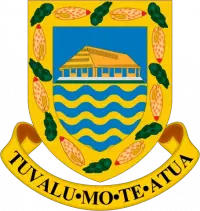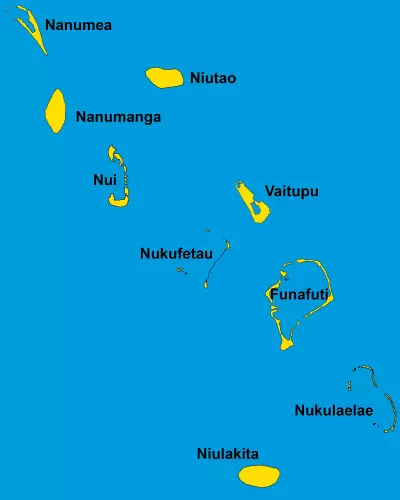The first Europeans to visit the territory of modern Tuvalu were Spanish explorers. In 1568, the Spanish navigator Alvaro Mendaña de Neira first reached the islands during his expedition across the Pacific Ocean. However, due to the remoteness of the archipelago and its insignificant resources, Tuvalu was of little interest to anyone for a long time. More active contacts with Western powers took place in the nineteenth century, when British traders, missionaries, and explorers began to visit the islands regularly. In 1892, Tuvalu (then part of the Gilbert and Ellis Islands) officially became part of the British Western Pacific Colony. Colonization took place peacefully, with the establishment of a British administration that gradually took control of the local islands to protect trade routes in the Pacific. The colony's flag was blue with the image of Union Jack in the upper left corner, symbolizing the connection to Great Britain. On the right side of the flag was an emblem similar to the modern flag of Kiribati, depicting a golden frigate flying over a rising sun above three blue waves.

In 1976, the Gilbert and Ellis Islands were officially divided into two separate territories: Tuvalu and Kiribati. Tuvalu, as a separate territory, began to form its own national symbols. Although full independence was still a few years away, this period was an important stage in the transition to self-government and the creation of a new flag. The flag of that period was common for British colonies, with the Union Jack dominating the upper left corner, but it differed from the previous flag by the symbol on the right side - it was the Tuvaluan coat of arms. It is worth noting that the national coat of arms of Tuvalu has not changed since its adoption in 1976 and is still used in the same form.
Meaning of the symbols of the coat of arms of Tuvalu

- Shield: The central element of the coat of arms, which depicts a hut against the background of waves, symbolizing the island life of Tuvalu. But this is not an ordinary hut, it is the largest building, the basis of government on the island, the heart of any community, which is called Maneapa. Maneapa serves as a place for meetings and decision-making;
- Waves: The lower part of the shield contains blue waves on a golden background, which symbolize the Pacific Ocean surrounding Tuvalu. The ocean plays a key role in the lives of the people of Tuvalu as a source of food, transportation and communication;
- Framing of the shield: The shield is framed by a pattern of banana leaves and “mitres” shells. The banana leaves symbolize abundance and life resources, while the “mitres” are shells used in local jewelry and crafts;
- The slogan “Tuvalu mo te Atua”: The ribbon under the shield that reads “Tuvalu with God” reflects the religiosity of the Tuvaluans and the role of Christianity in the country's life and spirituality.
After the country gained independence from Great Britain in 1978, a new flag was officially adopted. It still featured the Union Jack in the upper left corner, indicating affiliation with the Commonwealth of Nations, but the blue background was replaced with a blue hue. The main element of the flag was also changed, with nine stars symbolizing each of Tuvalu's nine inhabited islands replacing the coat of arms.

The name of the country Tuvalu translates as “eight islands” or “eight standing together”. It comes from the local language and reflects the fact that eight of the nine islands of the Tuvalu archipelago were originally inhabited. It was only later that the ninth island, Niulukita, became part of the kingdom, but the name remained unchanged. That is why in 1995 the number of stars was reduced to 8, in line with the country's name. However, the population did not accept this change, protests began and flagpoles with new flags were even cut down. Under such pressure, the flag could survive for only two years, after which on April 11, 1997, it was decided to return to the flag design of October 1, 1978. An interesting fact is that after that, the 9th atoll of Tuvalu was settled in accordance with the national flag. This turned out to be easier than changing the country's historic national pride.










